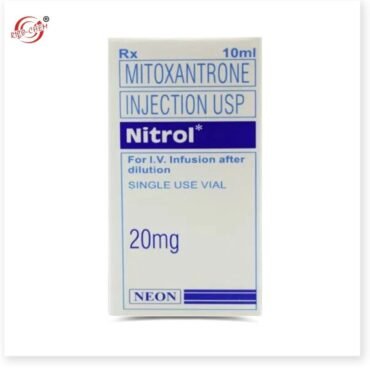Cytarabine Injection 500mg Oncotar
Trade Name: Oncotar
Manufacturer: United Biotech Pvt Ltd
Presentation: Injection
Strength: 500mg
What is Cytarabine Injection 500mg used for?
Cytarabine Injection 500mg is used to treat some kinds of leukaemia (cancer of the white blood cells), such as acute myeloid leukaemia (AML), acute lymphocytic leukaemia (ALL), and chronic myelogenous leukaemia (CML), either alone or in combination with other chemotherapy medications (CML).
What type of chemo is cytarabine?
Type of medication: Cytarabine is an anti-cancer chemotherapeutic medication (sometimes known as “antineoplastic” or “cytotoxic”). This drug is referred to as a “antimetabolite.” (See the “How cytarabine Works” section below for further information.)
How often is cytarabine given?
Intermittent dosing: Cytarabine can be given in five-day intervals as 3-5 mg/kg intravenous doses. This course of treatment can be repeated every 2 to 9 days until the desired therapeutic response or toxicity is achieved.
Can cytarabine cause fever?
Fever can develop after receiving cytarabine and for up to 24 hours following. Eye drops with large doses of cytarabine may help with conjunctivitis. Children experience more vomiting issues after receiving intrathecal cytarabine than they do after receiving intrathecal methotrexate.
Do you lose your hair with cytarabine?
It’s also FDA-approved for use in the treatment of acute myeloid leukaemia, acute lymphoblastic leukaemia, and chronic myeloid leukaemia in combination with other medications. Some persons may experience transient hair loss as a result of this medication. Normal hair growth should resume after the cytarabine medication is finished.
How effective is cytarabine?
Overall survival rates with cytarabine in conventional and high dose regimens are around 40%, with remission rates of 70–80% and relapse-free 5-year survival rates of 40-70 percent [15]. When compared to palliation, standard intensive treatment improves early death rates and long-term survival.
Where does cytarabine come from?
Four decades ago, the separation of C-nucleosides from the Caribbean sponge Cryptotheca crypta laid the groundwork for the development of cytarabine, the first marine-derived anticancer drug. Cytarabine is being utilised in the treatment of leukaemia and lymphoma patients. To know more click here.
How is cytarabine excreted?
Elimination Urine excretes cytarabine and its inactive metabolite. CSF bulk flow and diffusion to plasma clear the intrathecal dosage; CSF deaminase levels are minimal. Unless otherwise noted, the side effects reported below were from standard dosage therapy.
How does cytarabine affect the skin?
Cytarabine might create a rash that is itchy and red. Your skin may get red or blistered as a result of this. Your skin may peel if you take a high dose of cytarabine. Any changes in your skin should always be reported to your doctor or nurse.
Does cytarabine cause anaemia?
Reactions that are expected. Because cytarabine is a bone marrow suppressor, it can cause anaemia, leukopenia, thrombocytopenia, megaloblastosis, and decreased reticulocytes. The intensity of these reactions is determined by the dose and time of administration.
We are a Global Wholesaler and Exporter from India and Operate in more than 5 Countries like UAE, Oman, Qatar, Saudi, Myanmar, etc. If you are looking for a Product or Brand To Click here.







